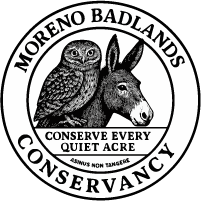History of The Badlands
Indigenous Stewards of the Land
Long before Spanish explorers arrived, the hills and canyons of the Moreno Valley Badlands were home to thriving Native American communities. Serrano, Cahuilla, and Luiseño peoples lived in balance with the land, harvesting wild foods, tending ecosystems through controlled burns, and moving seasonally to allow natural regeneration. Their relationship with the land was not just practical, it was deeply spiritual. Every canyon, ridge, and creek carried names and stories long before European settlers arrived. Sacred mountains, such as Mount San Jacinto, loomed large in their mythology.
Today, the echoes of their stewardship remind us that conservation is not a new idea, but a tradition reaching back thousands of years.
Spanish Mission Era and the Origins of San Timoteo and San Jacinto
In the late 1700s, Spanish expeditions traversed the region, bringing new names and new patterns of land use. Around 1774, Juan Bautista de Anza's expedition named the prominent eastern mountain San Jacinto after Saint Hyacinth, a 13th-century Dominican missionary.
By the early 1800s, Spanish missions established grazing outposts across the inland valleys. As part of this expansion, the name San Timoteo (for Saint Timothy) was given to the canyon that today slices through the Badlands.
Later, as Mexico secularized the missions and created private land grants, the names San Jacinto and San Timoteo became fixtures in the landscape. These names carry not only historical meaning but a moral weight, they tied natural places to human ideals of devotion, courage, and sacred duty.
Legacy of the Saints: Courage and Care
The two saints whose names bless our region offer powerful examples for today's conservation work.
Saint Timothy, the first Bishop of Ephesus, was a young leader who defended what he believed sacred, even at great personal cost. According to tradition, Timothy was martyred for opposing destructive pagan practices that defiled natural spaces. His life inspires steadfastness in protecting what is valuable.
Saint Hyacinth, known as the "Apostle of the North," traveled extensively to spread hope and safeguard treasures. His most famous miracle, carrying sacred objects to safety and crossing a river miraculously, reminds us of the power of determination and reverence for what must be preserved.
Both saints model the values we seek to live today: courageous action, reverence for the sacred, and building lasting pathways between communities and the natural world.
From History to Mission
The Badlands are not simply hills and canyons. They are a living, breathing heritage, first tended by Indigenous peoples, later renamed in honor of saints, and today entrusted to us.
The Moreno Badlands Conservancy stands on the shoulders of those who came before: Indigenous stewards, missionaries, settlers, and visionaries who recognized that some places deserve not just to be used but protected.
In honoring their legacy, we honor the land, preserving it for the generations who will one day walk these same canyons, look up at these same peaks, and draw strength from the enduring spirit of the Badlands.
Sources
- City of San Jacinto Historical Resources
- Moreno Valley Historical Society Archives
- Traditional Ecological Knowledge (TEK) research, University of California Publications
- Encyclopedia Britannica, entries on Saint Timothy and Saint Hyacinth
- Catholic News Agency profiles on early saints
- Local records on Juan Bautista de Anza expeditions
- San Bernardino de Sena Estancia historical documents
